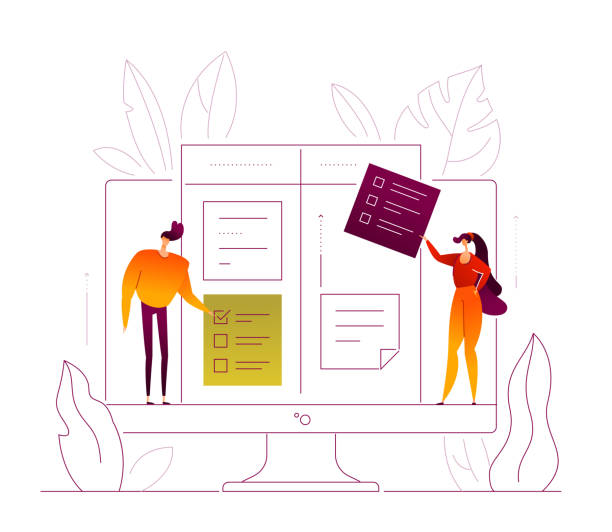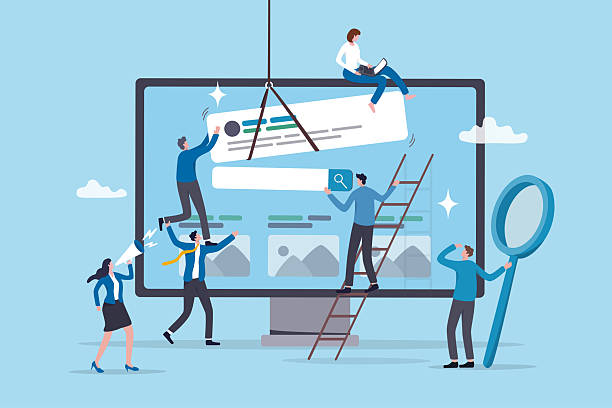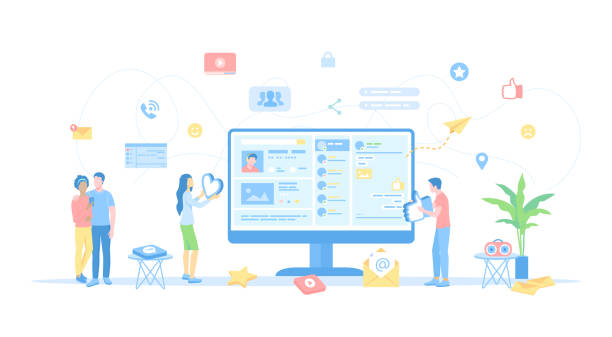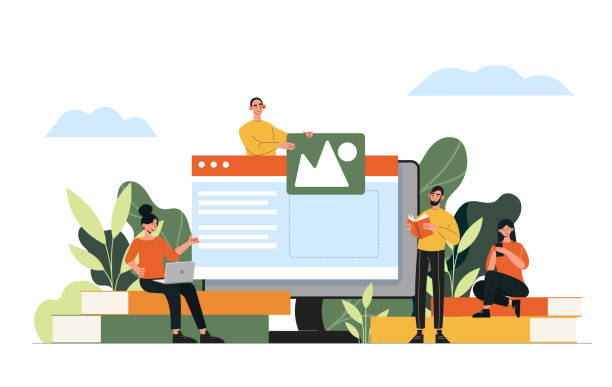Introduction to the Importance of Secure Website Design and its Place on the Web

In today’s information age, where all aspects of our lives are tied to the #internet, #website security has become more vital than ever.
Secure website design is no longer a luxury option, but an undeniable necessity for any business or individual intending to operate online.
The goal of this article is to provide a comprehensive and educational overview of the various aspects of this vital topic.
From the perspective of web design, security must be considered from the very initial stages of the project, not as an add-on after completion.
Disregard for this principle can lead to irreparable damages, including data loss, disclosure of confidential user information, brand reputation damage, and even heavy financial penalties.
Imagine a website launched without considering cybersecurity protocols; this website will become an easy target for cyber attacks.
This domain not only includes protecting data from unauthorized access but also ensuring the stability and availability of web services.
Websites, due to storing personal, financial, and commercial information, are attractive targets for cybercriminals.
Therefore, a deep understanding of the strategies and tools necessary for building a secure website is essential for every developer and business owner.
This section was an explanation of the importance of a proactive approach in this crucial area.
Are you worried that your company’s old website is driving away new customers? Rasaweb solves this problem with modern and efficient corporate website design.
✅ Increases your brand’s credibility.
✅ Helps attract targeted customers.
⚡ Contact Rasaweb for a free consultation!
Common Web Security Threats and Specialized Countermeasures

In the complex world of the web, cyber attacks appear in various forms, each capable of severely damaging a website.
Understanding these #threats and methods of #countering them is the cornerstone of any secure website design.
Among the most common attacks is SQL Injection, where an attacker injects malicious SQL code through website inputs to gain access to the database.
XSS (Cross-Site Scripting) attacks also target user browsers by injecting malicious scripts into web pages.
DDoS (Distributed Denial of Service) attacks cripple websites by flooding them with a massive volume of traffic.
Furthermore, phishing attacks and Brute Force (exhaustive search) attacks to gain access to user accounts are other serious threats.
To counter these threats, an analytical and specialized approach is necessary.
Key solutions include using Web Application Firewalls (WAFs), performing precise input validation, encrypting sensitive information, and implementing strong authentication mechanisms.
Additionally, regular updates of systems and software to fix known vulnerabilities are of high importance.
Without a robust defense strategy, even the best secure website design can fail.
This section examined the risks in detail and provided specialized solutions.
Fundamental Principles and Key Protocols in Secure Website Design

The foundations of website #security rest upon a set of key #principles and #protocols that every developer must understand and implement.
This section provides a comprehensive guide on the specialized aspects of these principles.
The most important step in secure website design is the use of the HTTPS protocol.
HTTPS, built upon SSL/TLS, encrypts traffic between the user’s browser and the web server.
This prevents eavesdropping and data tampering during transmission and creates a fundamental layer of protection.
Ensuring precise input validation is also crucial; any data received from the user must be checked for format, type, and content before processing or storage to prevent the injection of malicious code or data.
Additionally, using HTTP security headers such as Content Security Policy (CSP) and X-Content-Type-Options can be effective in preventing XSS and Clickjacking attacks.
The Principle of Least Privilege also means that every user or system component should only have access to the minimum resources and permissions necessary to perform their task.
This approach significantly prevents damage propagation in case of a breach.
Below, a table of the most important security principles is provided:
| Principle | Description | Importance |
|---|---|---|
| HTTPS/SSL/TLS | Encrypting communication between user and server | Protecting data during transmission |
| Input Validation | Reviewing and sanitizing all user input data | Preventing injection attacks (SQLi, XSS) |
| Proper Error Handling | Providing generic error messages to the user and logging details for the administrator | Preventing the disclosure of sensitive system information |
| Session and Cookie Security | Using HttpOnly and Secure flags for cookies, scheduling session expiration | Protection against Session Hijacking |
| Access Management | Applying the Principle of Least Privilege for users and processes | Reducing the scope of damage in case of a breach |
These principles form the foundation of any secure website, and their correct implementation is among the first steps on the path to creating a secure website.
This section was entirely technical and instructive.
The Role of Platform and Hosting Selection in Your Website’s Security

When it comes to website #security, choosing the right #platform and #hosting can be as important as secure coding.
This is an important #explanatory and #guiding point for anyone looking for secure website design.
Using a Content Management System (CMS) like WordPress, Joomla, or Drupal requires extreme care in security settings.
While these platforms are powerful in themselves, improper configuration, use of untrusted plugins and themes, or failure to update them regularly, can create major vulnerabilities.
For example, many attacks on WordPress websites stem from vulnerable plugins or weak administrator passwords, not the WordPress core itself.
Choosing a reputable hosting provider is also a crucial factor.
A good hosting service should offer security features such as hardware and software firewalls, Intrusion Detection Systems (IDS), regular malware scanning, and regular backups.
Shared hosting might be suitable for small websites, but if the provider does not adhere to security standards, it can pose risks; your website shares server space with other websites.
For larger or more sensitive websites, Virtual Private Servers (VPS) or dedicated servers are recommended, as they provide more control over the security environment.
Also, the location of the servers and adherence to data protection laws in those countries should be considered.
An analytical approach in selecting these factors will guarantee a fundamental part of your website’s security.
This section clearly and instructively addressed the infrastructural aspects of security.
Did you know that customers’ first impression of your company is your website? Multiply your business’s credibility with a powerful corporate site from Rasaweb!
✅ Custom and eye-catching design tailored to your brand
✅ Improved user experience and increased customer attraction
⚡ Get a free website design consultation!
Password Management and Strong Authentication: Essential Steps

One of the most vulnerable points in any online system is user #authentication.
#Password management and strong #authentication mechanisms are considered main pillars of creating a secure website.
This section provides an educational and specialized guide to strengthening this area.
First, websites should encourage users to use strong passwords; passwords that include a combination of uppercase and lowercase letters, numbers, and symbols, and are of sufficient length (at least 12-16 characters).
Storing passwords as hashed values using strong algorithms like Bcrypt or Argon2, along with a “Salt” unique for each password, is essential to prevent dictionary and Brute Force attacks.
Passwords should never be stored in plain text.
Secondly, implementing two-factor authentication (2FA) or multi-factor authentication (MFA) adds a significant layer of security.
This mechanism, in addition to the password, requires a second factor (such as a code sent to a mobile phone or an authenticator app), which makes it much harder for an attacker to breach even if the password is compromised.
To enhance security, using CAPTCHA in login and registration forms to prevent automated attacks (bots) is also recommended.
Furthermore, mechanisms should be in place to lock user accounts after multiple failed login attempts, and to send security alerts to the user if suspicious activities or login attempts from unusual locations are detected.
These preventive measures significantly increase website security against unauthorized access.
This section is not questionable, but a decisive guide for improving security.
Continuous Updates and Security Patches: News from the Web World

In the ever-changing world of #cyberspace, continuous #software updates and applying #security patches are a fundamental principle in secure website design.
This is an important and #explanatory piece of news that every webmaster should be aware of.
New security vulnerabilities are discovered daily, and software developers (such as server operating systems, CMSs, plugins, and libraries) quickly release patches and updates to fix them.
Ignoring these updates means leaving the doors open for attackers.
News indicates that many successful cyber attacks result from exploiting known vulnerabilities for which a patch had already been released but not applied.
This includes the CMS core, all plugins, themes, and even the server environment (such as PHP, MySQL, or Apache versions).
Establishing a regular schedule for reviewing and applying updates is essential.
Furthermore, before applying any major update, creating a backup of the website and database is strongly recommended to allow for reversion in case of issues.
In cases where updates lead to incompatibilities, a solution must be found quickly or backups must be used.
Automated tools for monitoring vulnerabilities and notifying about new updates can also be very useful.
Disregarding this aspect of website security can nullify all previous efforts to build a secure site and expose the website to serious risks.
This section highlighted the news and explanatory aspect of updates.
Regular Backup and Disaster Recovery Plan for Website Security

Even with the most meticulous approach in #secure website design, unforeseen events such as hardware failure, severe cyber attacks, or human error can occur.
In such circumstances, having a regular #backup and a #disaster recovery plan acts as #insurance for your website’s security.
This is an instructive and specialized guide to ensuring the survival of your data.
Backups should include all website files (code, images, media files) and the database.
Various backup methods exist: from manual backups to automated hosting tools or CMS plugins.
Regular and automatic backups, especially off-site or in cloud storage, are crucial to ensure the security and accessibility of backup copies in case of primary server loss.
Also, multiple backup versions from different times should be kept so that if a recent version is compromised, one can revert to healthier versions.
A Disaster Recovery Plan is a set of procedures that specifies how to recover systems and data after a catastrophic event.
This plan should include steps for problem detection, damage isolation, recovery from backups, and service restart.
Regular testing of the recovery plan is as important as the plan itself; it ensures that everything proceeds according to plan during a crisis.
Imagine an e-commerce website suffering a ransomware attack with no backup available; this could mean the end of the business.
This is where the value of a strong recovery plan becomes evident.
Below, a table of best backup and recovery practices is provided:
| Item | Description | Importance |
|---|---|---|
| Backup Frequency | Depends on website changes (daily, weekly) | Minimizing data loss |
| Off-site Storage | Keeping backups in a location separate from the main server | Protection against server disaster |
| Recovery Testing | Regular testing of the data recovery process | Ensuring the effectiveness of the recovery plan |
| Versioning | Keeping multiple backup versions from different times | Ability to revert to healthy past versions |
| Backup Encryption | Encrypting backup files to protect sensitive information | Data security even after unauthorized access to backup |
This comprehensive approach complements all efforts towards secure website design and creating a disaster-resilient website.
Penetration Testing and Vulnerability Assessment: Analytical and Essential

After implementing all security measures, how can their effectiveness be ensured? The answer lies in #Penetration Testing and #Vulnerability Assessment.
These two #analytical and #specialized processes are vital for anyone seeking secure website design.
Vulnerability assessment involves using automated tools to scan the website and identify known weaknesses.
These tools can quickly find thousands of potential vulnerabilities in code, server configurations, or software used.
This process is faster and less costly than penetration testing and provides an overall view of the website’s security posture.
In contrast, penetration testing is a controlled simulation of a real cyber attack performed by security professionals (usually ethical hackers).
The goal of this test is to find ways to breach the system and access sensitive information, just like a real attacker would.
This process is much deeper and more comprehensive and can discover more complex and logical vulnerabilities that might be overlooked by automated scanners.
Regular performance of these tests, especially after major website changes or before official launch, is strongly recommended.
These processes not only reveal weaknesses but also help you view security challenges in an #entertaining or at least exciting way, increasing your readiness to face real attacks.
The results of these tests must be carefully analyzed, and a plan to fix all discovered vulnerabilities should be created.
This analytical approach keeps your website one step ahead of attackers and helps ensure website security.
Is your current e-commerce website design causing you to lose customers and sales?
Rasaweb is your solution with modern and user-friendly e-commerce website designs!
✅ Significantly increase conversion rates and sales
✅ Build strong branding and gain customer trust
⚡ Get a free e-commerce website design consultation from Rasaweb!
User Awareness and the Role of Education in Maintaining Security (Challenging Content)

While technology and secure coding are very important, often the #weakest link in the security chain is the #human factor.
User #awareness and continuous #education play a vital role in maintaining secure website building.
This is a challenging yet educational content: Can we achieve complete security without user awareness? The answer is no.
Social Engineering attacks such as phishing, spear phishing, and malware hidden in links or attached files, target users.
Even the most secure infrastructures cannot withstand a user who inadvertently discloses sensitive information or clicks on a malicious link.
Therefore, part of a secure website design strategy must include user education.
These trainings can include: how to detect phishing emails, the importance of using strong and unique passwords, the risks of downloading files from untrusted sources, and the importance of reporting suspicious activities.
For websites with an administration section or user panel, educating staff and administrators about best security practices, including proper credential management, using secure networks, and identifying threats, is of paramount importance.
Cultivating a security culture within the organization, through conducting workshops, sending security newsletters, and creating easily accessible guides, can significantly reduce the risk of successful attacks.
This aspect of security is often overlooked, but considering the analysis of cyber attacks, the human role in the success or failure of security is very prominent.
Can we educate users enough so that they never fall victim to these attacks? Perhaps not, but we can minimize the risk.
This challenging section highlighted the importance of the human aspect of security.
The Future of Secure Website Design and Emerging Trends

The world of #cybersecurity is rapidly changing, and #secure website design must keep pace with these #trends.
An #analytical and #news-oriented look at the future of this field is essential for maintaining security in the coming years.
With technological advancements, attackers are also using more sophisticated tools.
Artificial intelligence and machine learning, currently assisting in cyber defense, will soon be employed by attackers to create more advanced attacks (such as automated malware generation or targeted phishing attacks).
This increases the need for smarter and more adaptable security solutions.
Furthermore, with the expansion of the Internet of Things (IoT), more entry points are created for attackers, which can connect to websites and networks, bringing new threats.
On the other hand, technologies like blockchain and quantum cryptography are being developed, which can create new paradigms in web security.
Blockchain can be used to increase transparency and security in information logging and authentication, while quantum cryptography promises to render current encryption systems obsolete and necessitate new algorithms.
Approaches like “Security by Design” and “Zero Trust”, which assume no user or device is trustworthy unless continuously authenticated and verified, will increasingly gain importance.
These approaches emphasize that security must be embedded from the outset in every layer of the system.
To maintain website security in the future, organizations and developers must adapt to these changes, continuously educate themselves, and invest in leading security technologies.
This section provided a news and analytical perspective on the future of this important field.
Frequently Asked Questions
| No. | Question | Answer |
|---|---|---|
| 1 | What is secure website design? | Secure website design is a process where websites are built considering security measures from the initial stages of development to protect against cyber attacks, unauthorized access, and data loss. |
| 2 | Why is secure website design important? | Website security is vital for maintaining user trust, protecting sensitive information (personal and financial), preventing damage to brand reputation, and complying with privacy and security regulations (such as GDPR). A security breach can lead to financial and legal damages. |
| 3 | What are the most common cyber attacks a website faces? | Some of the most common attacks include SQL Injection, Cross-Site Scripting (XSS), Distributed Denial of Service (DDoS), Brute Force, and credential-based attacks (Credential Stuffing). |
| 4 | What is SQL Injection and how to prevent it? | SQL Injection is a type of attack where an attacker attempts to manipulate the database or extract information by injecting malicious SQL code into site inputs. To prevent it, Prepared Statements/Parameterized Queries, ORM (Object-Relational Mapping), and precise input validation should be used. |
| 5 | What is Cross-Site Scripting (XSS)? | XSS is a type of attack where an attacker injects malicious scripts (usually JavaScript) into web pages, which are then executed by other users’ browsers. This can lead to the theft of cookies, session information, or alteration of the website’s appearance. |
| 6 | How can Brute Force attacks on login pages be prevented? | To prevent Brute Force attacks, CAPTCHA, limiting the number of failed login attempts (Account Lockout), two-factor authentication (2FA), and using complex and long passwords should be employed. |
| 7 | What is the role of HTTPS in website security? | HTTPS encrypts the communication between the user’s browser and the website server using SSL/TLS. This prevents eavesdropping, tampering, or spoofing of information during transmission and increases user trust. |
| 8 | What is the importance of Input Validation in security? | Input validation is the process of checking and sanitizing data entered by the user. This prevents the injection of malicious code, XSS attacks, SQL Injection, and other vulnerabilities, and ensures that data conforms to the expected format. |
| 9 | Why are regular updates of website systems and software essential? | Regular updates of the operating system, CMS (like WordPress), plugins, themes, and libraries used, fix known security vulnerabilities. Hackers often exploit weaknesses in outdated software to gain unauthorized access. |
| 10 | What role do regular backups play in secure website design? | Regular and tested backups of website data (database and files) are a vital layer of defense against data loss due to cyber attacks, human errors, or hardware failures. This allows for quick website recovery in the event of a disaster. |
And other services of Rasa Web Advertising Agency in the field of advertising
How advertising helps develop new markets for perfumes
Techniques to increase audience engagement with commercial advertisements
How advertising helps introduce specific perfume brands
Importance of tracking ad results to improve strategies
How to participate in virtual exhibitions with advertising
And over a hundred other services in the field of internet advertising, advertising consultation, and organizational solutions
Internet Advertising | Advertising Strategy | Advertorial
🚀 Are you ready to transform your business in the digital world?
With Rasaweb Afarin Digital Marketing Agency, you no longer have to worry about your business going unnoticed. With our expertise in areas such as WordPress website design, Search Engine Optimization (SEO), and comprehensive digital marketing strategies, we build a strong bridge between you and your customers.
Contact us today for a free consultation and secure the digital future of your business!
📍 Tehran, Mirdamad Street, next to Bank Markazi, Southern Kazeroon Alley, Ramin Alley, No. 6



